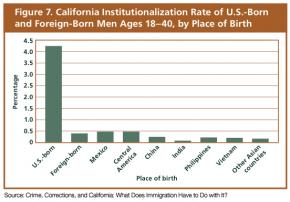O’Reilly’s “immigrant crime wave” fraud
dismantles the myth that immigrants are responsible for violence and crime.
"PHOENIX IS the kidnapping capital of the United States," hyperventilated Fox News blowhard Bill O'Reilly on May 14. "Crime is through the roof. Drugs are coming across the border all the time. So what do you expect Arizona to do?"
For the fifth time in 12 days, O'Reilly was making what he takes to be the central justification for Arizona's SB 1070: the state's skyrocketing crime rate.
SB 1070 is the draconian new anti-immigrant law that makes it a crime not to carry immigration documentation and mandates police to inquire about the status of anyone they "reasonably" suspect of being in the U.S. illegally. And not a moment too soon as far as O'Reilly is concerned.
In lashing out at immigrants with this kind of rhetoric, O'Reilly wasn't demonstrating any originality. In May 2006, George W. Bush used his national address on immigration reform to assert that "illegal immigration...brings crime to our communities."
There's only one small hitch in O'Reilly's master plan to solve Arizona's "crime wave": Arizona's crime rate has been falling for several years, even as the number of immigrants to Arizona, both documented and undocumented, has been increasing.
What's more, study after study has shown that foreign-born immigrants are, in fact, less likely than native-born white Americans to commit crimes.
This fact--foreign-born immigrants commit crimes at a lower rate than the native-born--is so at odds with the stereotype that criminality runs rife among recent immigrants and in border communities that confronting politicians and pundits with the facts seems to matter little.
On May 18, the day after Fairness and Accuracy in Reporting issued an action alert calling on O'Reilly to back up his claims with facts or retract his slurs, O'Reilly was still at it.
In response to a guest who explained that El Paso, Texas, with its large community of recent immigrants, is among the safest big cities in the U.S., O'Reilly snapped, "That's a bunch of baloney."
As the debate about immigration has heated up in recent years, politicians and pundits alike have repeatedly linked immigrants and crime as a way to justify the increased number of crackdowns, raids and deportations, as well as the accompanying increases in government spending that go along with these measures.
The endless repetition of the assertion, no matter that it is directly contradicted by the evidence, has nevertheless had its impact. When asked whether "more immigrants cause higher crime rates," 25 percent of Americans replied "very likely" and another 48 percent said "somewhat likely," according to the National Opinion Research Center's 2000 General Social Survey. This three-quarters of the U.S. population that believes there is a causal link between immigration and crime is significantly greater than the 60 percent of people who think more immigrants are somewhat likely or very likely "to cause Americans to lose jobs."
Thus, Bill O'Reilly is appealing to a common misconception while simultaneously sustaining and further disseminating the lie on which it is based.
BETWEEN 1970 and the present, the proportion of the U.S. population that is foreign-born roughly tripled--from a historic low of 4.7 percent to a historic high of about 13 percent today.
Beginning in the early 1990s, the number of immigrants began increasing especially quickly, with economic growth in the U.S. creating a strong demand for labor that drew large numbers of immigrants from Mexico and Central America as well as the rest of the world.
From 1993 to 2006, according to a study titled "Undocumented Immigration and Rates of Crime and Imprisonment: Popular Myths and Empirical Realities" by sociology professor Rubén Rumbaut:
Over the same time period as legal and especially illegal immigration was reaching and surpassing historic highs, crime rates have declined, both nationally and most notably in cities and regions of high immigrant concentration (including cities with large numbers of undocumented immigrants, such as Los Angeles and border cities like San Diego and El Paso, as well as New York, Chicago and Miami)...
From 1994 to 2005, property crimes and violent crimes reached lows in the United States not seen in decades. (emphasis in original)
Rumbaut's analysis is even more powerful on the question of who goes to prison in the U.S.:
Inasmuch as the incarcerated population is overwhelmingly composed of less educated young adult males from ethnic minority groups--a profile which, as noted, fits a much greater proportion of the undocumented immigrant population--it follows that immigrants would be expected to have higher incarceration rates than natives. And immigrant Mexican men--who comprise fully a third of all immigrant men in the U.S. between 18 and 39--would be expected to have the highest rates...
However, the incarceration rate of the U.S.-born (3.51 percent) was five times the rate of the foreign-born (0.68 percent)...Of particular interest is the finding that the lowest incarceration rates among Latin American immigrants are seen for the least educated groups, who are also the groups who account for the majority of the undocumented: the Salvadorans and Guatemalans (0.52 percent), and the Mexicans (0.70 percent). (emphasis in original)
The contrast between incarceration rates for foreign- and native-born is even more striking in the case of California.
"Overall, native-born men age 18 to 39 in California have higher incarceration rates than the rest of the U.S., while the foreign-born have lower rates in California compared to the rest of the U.S.," according to Rumbaut. "The total incarceration rate for the U.S.-born is more than 1 percentage point higher in California than in the rest of the U.S. (4.5 to 3.4). In contrast, the rate for the foreign-born in California was less than half the foreign-born rate in the rest of the country (0.4 to 1.0)."
Another study focusing on California specifically considered whether the presence of a large number of immigrants might itself be responsible for this outcome. For example, if a large influx of immigrants displaced native-born workers from jobs, this could lead to greater criminal activity among native-born workers desperate to make ends meet.
But again, the statistics reveal the exact opposite. "We find that on average, between 2000 and 2005, cities that had a higher share of recent immigrants saw their crime rates fall further than cities with a lower share," according to Kristin Butcher and Anne Morrison Piehl, authors of "Crime, Corrections and California: What Does Immigration Have to Do with It?". "This finding is especially strong when it comes to violent crime."
Such findings are not that surprising. Immigrants to the U.S. have to be highly motivated to leave behind families, friends and familiarity with their home country in order to come to the U.S. Generally speaking, immigrants motivated enough to come to the U.S. do so in order to work hard and try to realize a small piece of the "American Dream."
"In addition, all non-citizens, even those in the United States legally, are subject to deportation if convicted of a criminal offense that is punishable by a prison sentence of a year or more, even if that sentence is suspended," according to Butcher and Piehl. "Furthermore, those in the country illegally have an additional incentive to avoid contact with law enforcement--even for minor offenses--since such contact is likely to increase the chances that their illegal status will be revealed."
Their findings led Butcher and Piehl to conclude that "spending additional dollars to reduce immigration or to increase enforcement against the foreign-born will not have a high return in terms of public safety. The foreign-born in California already have extremely low rates of criminal activity."
THE EVIDENCE demonstrating no link between high levels of immigration and high levels of crime goes all the way back to the late 19th and early 20th centuries--the last time there were levels of immigration that, proportionally speaking, rivaled today's wave of immigration.
According to Rumbaut, his findings about the lack of evidence for a link between immigration and crime
should not come as news, for they are not new--merely forgotten and overruled by popular myth. In the first three decades of the 20th century, during the previous era of mass immigration, three major government commissions came to similar conclusions. [Each commission] sought to measure how immigration resulted in increases in crime. Instead, each found lower levels of criminal involvement among the foreign-born and higher levels among their native-born counterparts.
As [one commission] concluded a century ago: "No satisfactory evidence has yet been produced to show that immigration has resulted in an increase in crime disproportionate to the increase in adult population. Such comparable statistics of crime and population as it has been possible to obtain indicate that immigrants are less prone to commit crime than are native Americans."
More than eight decades later, not surprisingly, the U.S. Commission on Immigration Reform concluded in a 1994 report that immigration is not associated with higher crime. The Commission compared crime rates in U.S.-Mexico border cities such as El Paso with cities elsewhere in the United States and found that crime rates generally were lower in border cities.
In fact, the only claim of O'Reilly's that even threatens to resemble the truth was his claim about Phoenix. Phoenix's crime rate has been falling, just like crime rates across the U.S. But there are a significant number of kidnappings in the city.
But those kidnappings are directly linked to increased border enforcement measures.
According to Phoenix police Sgt. Tommy Thompson, "We're talking about drop houses where people who have used coyotes to get into the country may be held for ransom," Thompson said. "And we're talking about the kidnapping of smugglers and associates. I have no fear that my kids or grandkids will be victims."
In other words, enforcement measures are contributing to, rather than curtailing, violence and other criminal activity along the U.S.-Mexico border--because such measures make it necessary for potential border crossers to seek out the services of coyotes (guides who charge hundreds or even thousands of dollars to border crossers seeking to enter the U.S. without papers) in order to evade border patrol agents.
But somehow I don't think O'Reilly will be calling for the one thing that would diminish such kidnappings--namely, a reversal of the enforcement measures that create the necessity for coyotes in the first place.
Instead, a rejuvenated immigrant rights movement must reject at every turn the spurious claims about immigration and crime--and demand accountability from public figures who are hyping a nonexistent crime wave among immigrants.




